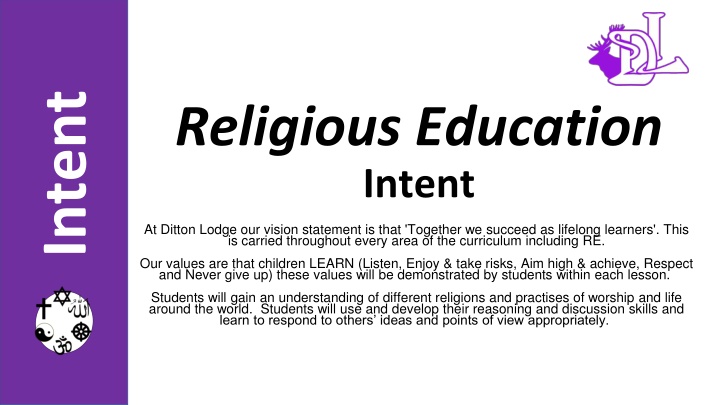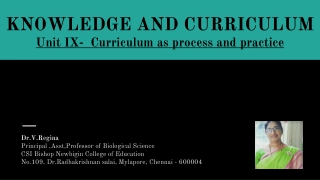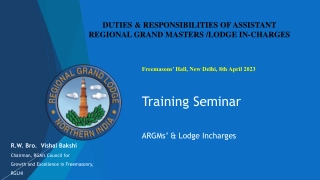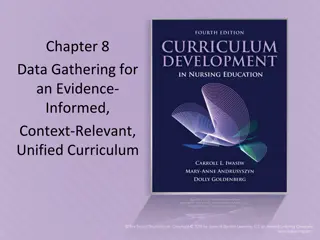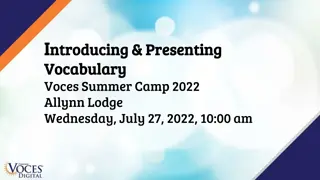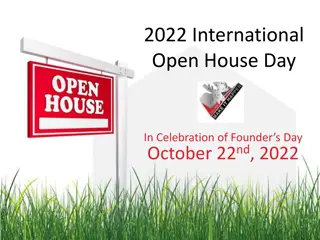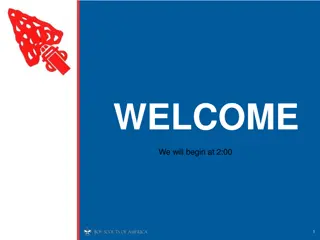Nurturing Religious Education: Empowering Students at Ditton Lodge
Embedding the vision of "Together we succeed as lifelong learners," Ditton Lodge Primary School prioritizes Religious Education to instill values of respect, open-mindedness, and self-awareness. Through a comprehensive curriculum, students explore diverse religions, emphasize reasoning and discussion skills, and cultivate attitudes of respect towards differing beliefs. The school aims to develop religious literacy, promote understanding of various faiths, and encourage informed judgments on religious issues.
Download Presentation

Please find below an Image/Link to download the presentation.
The content on the website is provided AS IS for your information and personal use only. It may not be sold, licensed, or shared on other websites without obtaining consent from the author.If you encounter any issues during the download, it is possible that the publisher has removed the file from their server.
You are allowed to download the files provided on this website for personal or commercial use, subject to the condition that they are used lawfully. All files are the property of their respective owners.
The content on the website is provided AS IS for your information and personal use only. It may not be sold, licensed, or shared on other websites without obtaining consent from the author.
E N D
Presentation Transcript
Intent Religious Education Intent At Ditton Lodge our vision statement is that 'Together we succeed as lifelong learners'. This is carried throughout every area of the curriculum including RE. Our values are that children LEARN (Listen, Enjoy & take risks, Aim high & achieve, Respect and Never give up) these values will be demonstrated by students within each lesson. Students will gain an understanding of different religions and practises of worship and life around the world. Students will use and develop their reasoning and discussion skills and learn to respond to others ideas and points of view appropriately.
Religious Education Intent At Ditton Lodge Primary School, we believe that students should learn to understand the beliefs and values of people they may encounter in life. In weekly lessons, students are exposed to a wide range of religious beliefs. They learn the correct vocabulary and terminology associated with these religions and are encouraged to express their opinions in an appropriate way both independently, in small groups and during whole class discussion. Throughout their time at Ditton Lodge, the curriculum is sequenced in order that students' knowledge and understanding progresses. This begins with students learning about and from religions and how religious belief contributes to the way a person lives their life to analysing, understanding and comparing religions.
Religious Education Intent Aims The aims of the Syllabus are for students: to develop religious literacy; to acquire and develop knowledge and understanding of Christianity and other principal religions and world views represented in the United Kingdom; to develop an understanding of the influence of belief, values and traditions on individuals, communities, societies and cultures; to develop attitudes of respect towards other people who hold views and beliefs different to our own; to develop the ability to make reasoned and informed judgements about religious issues, with reference to principal religions and world views represented locally and in the United Kingdom. (The Agreed Syllabus for Religious Education 2018-2023)
Religious Education National Curriculum Intent Although RE is a subject that must be taught in schools, there is no official National Curriculum document associated with the subject. At Ditton Lodge, we have chosen to follow The Cambridgeshire Agreed syllabus. This has been developed on the basis that knowledge, skills and understanding are essential to religious education. Underpinning this are four main values: self-awareness, respect, open-mindedness and appreciation and wonder. In lessons, the two main learning objectives are to firstly learn about religion and belief and secondly to learn from religion and belief. There are key learning themes that underpin the Cambridgeshire Syllabus.
Religious Education Why is RE important? Intent RE is a key subject that can often be undervalued as a curriculum area in today s society, despite playing a key role in many lives both throughout the world and in the United Kingdom too. In addition, religion contributes positively to the nation s well-being and develops a sense of self-worth, happiness and belonging. Religion is an integral part of many cultures and can provide opportunities to learn about global issues and historical events that changed the world. It also relates directly to events going on in the world today and students will see these things on television and social media. It is important that students have the ability to manage media and understand it factually and objectively.
Content and Sequence Throughout both Reception, Key Stage 1 and Key Stage 2, pupils learn about Christianity and other religions, recognising the impact of religion and belief both locally and globally. Implementation They: make connections between differing aspects of religion and consider different forms of religious expression; consider beliefs, teachings, practices and ways of life central to religion; learn about sacred texts and other sources and consider their meanings; begin to recognise diversity in religion learn about similarities and differences both within and between religions, and the importance of dialogue between people of different beliefs extend the range and use of specialist vocabulary communicate their ideas clearly, recognising other people s viewpoints consider their own (and others) beliefs and values in the light of their learning in religious education.
Numeracy & Literacy in RE Implementation RE not only provides opportunities for discussion and debate but enables access to a range of texts and artefacts, which students need to communicate their response to. The subject also builds on student's vocabulary with key words being learned and used in all lessons. During RE, students will encounter statistics and on occasion and where relevant, historical and calendar dates. Retrieval Practice Students will be revisiting different religions throughout their time at Ditton Lodge. What they are learning builds as they transition from Key Stage 1 to Key Stage 2. Through both quizzing and key questions, students will have the opportunity to revisit and revise what they have learned.
Cross Curricular Links Intent Religious education provides opportunities for pupils to develop the key skills of: Communication through developing a broad and accurate religious vocabulary, reading and responding to a range of written and spoken language, including sacred texts, stories, poetry, prayers and worship, communicating ideas using the creative and expressive arts, talking and writing with understanding and insight about religious and other beliefs and values, reflecting critically on ultimate questions of life, using reasoned arguments. Geography/History through using atlas' students will gain context from researching and locating places of religious significance. In addition, students will also gain an understanding of how certain religious figures and events have had an impact on history. Information and Communication Technology (ICT) through using the internet and media selectively, researching information about religion and belief. using computer programmes to present knowledge gained through study of religious education.
Progress Implementation EYFS uses the early years framework to cover Christianity and other religions represented in school. Within Key Stage One, students are working from Cambridgeshire Agreed Syllabus. The lessons cover and develop the themes that are set out within syllabus. Contents of lessons and planning is adapted to ensure that all students are supported in order that they can access the lessons. Where required, we have created differentiated resources and, where required, there are differentiation options available to ensure that all students are able to work to the best of their ability and achieve their potential. In Key Stage Two, students are continuing to work from the Cambridgeshire Agreed syllabus . Lessons build on topics learnt about in KS1 and also introduces new topics. This approach lends itself well to students developing their understanding and personal responses to religion and belief. Students revisit the same religions periodically and look at them under the different themes which builds on their knowledge and supports progression in their overall understanding of the subject as a whole.
Reading Reading forms part of almost all of our RE lessons. At Key Stage One level, students may work in small groups and pairs to read and discuss texts relevant to the topics covered. This reading will be scaffolded with students supported in mixed ability groupings and by differentiating text where required. At Key Stage Two level, students may also work in small groups, pairs or independently. Implementation Vocabulary Students will encounter lots of new vocabulary in their RE lessons. This is taught respectfully, and we insist on using the correct terminology in our lessons. Key vocabulary will be revisited throughout a topic to consolidate students knowledge and understanding. Oracy Oracy plays a huge part of our lessons. Students will spend a lot of their time here discussing key ideas and opinions. Students will be taught how to listen and respond to other people s comments including how to agree and disagree in a sensible and appropriate way. Writing Writing does not form a huge part of RE lessons. It is used however, in most lessons, for recording short ideas, opinions and responses. The presentation policy is adhered to with an expectation that written English is used appropriately. Students are expected to write extended pieces on occasion and these will be scaffolded and supported using writing frames, sentence openers and anything else as required in order that students can be successful.
Units of work: Key Stage One RE: LONG TERM PLAN AUTUMN TERM SPRING TERM SUMMER TERM Intent 1stHalf 2ndHalf 1stHalf 2ndHalf 1stHalf 2ndHalf YEAR ONE What makes Christian people special? Look at family life, are there any places that are special to you? Christmas Why is it important to Christians? (Other religious celebrations, Hanukah) Places in Christianity What makes a church a special place? Easter The Easter Story, why is it important to Christians? Why is Passover (Pesach) important to Jewish people? Explore the use of signs and symbols. What are religious symbols? Books and Stories. Which books are special to me and why? Links to The Bible and Torah. YEAR TWO The family in Christianity. What difference does belonging to a faith make to a family? Christmas How and why do people celebrate Christmas? People in Christianity- Who was Jesus? A great leader and teacher? What are the special religious texts? Sikhism Self and Community. How does the Khalsa influence the lives of Sikh families? Books, stories and symbols. How do the stories from the Gurus and the concept of Seva (selflessness) affect Sikh children?
Units of work: Lower Key Stage Two YEAR THREE Christianity- What do Christians believe about the creation of the world? How is this similar or different to beliefs about creation? (Religious and secular) Celebrations- The Church Year, Christmas. How is Christmas celebrated around the world? Judaism What is important for Jews about being part of God s family? Sacred writings (Bible and Torah) What are the similarities and differences (Daniel and the Lions, Noah s Ark, Jonah and the Whale) Explore Family Life Special clothes, places of worship and Holy days. What do we like about the world? Explore experiences of the natural world. Intent YEAR FOUR Different places of Christian worship. How and why are churches different? Commitment and Belonging. What are the similarities and difference across different religions ? (f ocus to be Christianity and Islam) Church People Who are the saints of God? Why are they important? The Easter Story Is Easter a festival of new life or sacrifice? What is temptation? Islam What do Muslims believe? What are the five pillars of Islam? Islam What is prayer? Why is prayer important to Muslims?
Units of work: Upper Key Stage Two YEAR FIVE Intent Christianity Jesus, an inspirational leader. Who are inspirational figures from history? Christians in other parts of the world. What is it like to be a Christian in Vellore? Humanism What are the key beliefs of Humanism? Easter around the world. How is Easter celebrated around the world? What unfamiliar tra ditions and celebrations are there? What is Buddhism? Who was Siddharta Gautama? Buddhism around the world. What does it mean to be a Buddhist? YEAR SIX Jesus Who do people say I am? What metaphors ar e used in the Bible to describe Jesus? The life of Jesus. The timeline of the life of Jesus. What miracles did he perform? People of Faith, Courage and Commitment. What does it mean to have faith? (Research people form history as well as those still living that have demonstrated courage, faith and commitment) Easter - What happens when life ends? What are the different religious and secular beliefs about what happens when life ends? Hinduism The Hindu community. What does it mean to be Hindu? What does Diwali mean to Hindus? Hinduism What can the stories and images tell us about Hindu beliefs? What is Puja and why is it important to Hindus?
Implementation Example of planning Although we follow the same syllabus for Key Stage One and Two, we do adapt the plans in order that they are sufficient for both teachers to teach from and for students to learn. Teachers are non-specialists and the plans have therefore been set out to ensure that staff have the information and training they need in order that they can successfully deliver the lessons to our students.
Example of planning: Key Stage One R.E Year 1 Core unit - Places in Christianity Lesson 1 - Duration 1 hour Learning Objectives: To be aware that churches may be different from each. Other. Implementation Learning Outcomes I can identify similarities between two Churches. Key Vocabulary Denomination similarities Church difference Features Symbols Key Questions Are all churches the same? Resources R.E Folders Local church IWB Introduction: Use pictures showing the exterior of a variety of churches of different denominations. Can the pupils identify what all the buildings are? What is the same? What is different? How can they tell if it is a church? On IWB, have a variety of pictures of the insides of buildings including the insides of churches from different denominations. Ask pupils to sort them into those that are churches and those that are not. How do they know? How are the churches the same? How are they different? Use enlarged pictures of 2 different types and see if pupils can identify the key features. Ask pupils which they prefer and why. Why do they think people prefer different places to worship? Use a large map of the area and see if they can locate all the different churches. Prior Learning Assessment opportunities Level 1 I can identify a church building by some of its features. Level 2 I can identify similarities between two churches. Level 3 I can describe some similarities and differences between two different Churches, using a developing religious vocabulary. Notes Be aware of children from different faith backgrounds, whom may not have any first-hand experiences of visiting a Christian church. Give these children the opportunity to talk about their experiences of places of worship.
Example of planning: Key Stage Two R.E Year 6 Core Unit-Hinduism-What can stories and images of deities tell us about Hindu beliefs Duration 1hr Learning Objectives: To understand the importance of visual expressions for Hindu deities. To consider how meanings can be conveyed through symbols. To understand the Hindu belief that life is cyclical. Learning Outcomes I can make links between the features of the murtis and Hindu beliefs about God. Key Vocabulary Deity Hindu/Hinduism Murti (An image that expresses a divine spirit) Brahma, Vishnu, Shiva Lakshmi and Ganesh Resources R.E Books Images of Hindu Gods Introduction Either as a class on the IWB or allow children to carry out a Google image search for Brahma, Vishnu, and Shiva. Talk about what similarities between the different images of the same deity can they spot? Why is this? What reasons can they suggest for any differences? (Different images may contain different items of importance or different symbols) Look at some images of Lakshmi and Ganesh what do they recognise? Talk as a class about the value of using symbols to show what is important and of value. Where else have they come across symbols being used to express important ideas and what people believe? E.g., emblems of societies, football teams badges. Think about things they value, or think are important. How would they symbolise them? A key belief in Hinduism is that life is cyclical, cycle of life (birth, life, death and rebirth) If you had to show your thoughts about God and the cycle of life, what shape would it be? Design one symbol, draw it in R.E books and write an explanation of your thinking behind the symbol. Assessment opportunities Level 3 I can identify things that are important to me and express them in a symbol Level 4 I can explain how symbols help people to express beliefs and my own beliefs Level 5 I can explain what some of the images of the deities say about Hindu beliefs about God Implementation Key Questions How can symbols express meaning? Prior Learning Religious symbols Notes Be aware of any students who may have suffered a bereavement as discussing the topic of reincarnation may be emotive.
Impact Religious Education Impact
How do you document learning, monitor progress and achievement? Impact Students are expected to record learning in their exercise books in almost all lessons. This may take the form of writing, mind maps, pictures etc and will involve students answering specific questions. This work in students books should take into account the school s presentation rules and minimum expectations. During lessons, teachers may use discussion to support students in self-assessing their work and they may be asked to edit and improve their work during this time using blue pen. During each individual lesson, teachers will use the school s marking policy in order that they can assess students progress against the lessons objectives. This also takes into account how far students have used the minimum expectations set out in this policy. By the end of the lesson, staff are expected to know whether students have achieved the objective and teaching in the next lesson will be adapted if needed to ensure that understanding is complete, and any misconceptions have been addressed.
Impact How do you measure the impact of Religious Education teaching?
